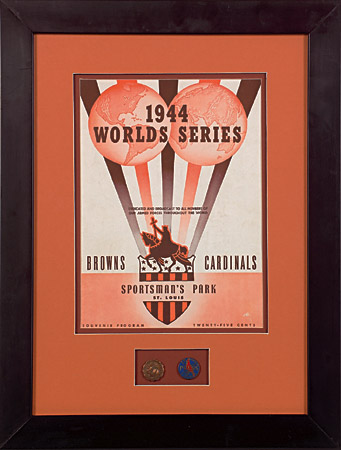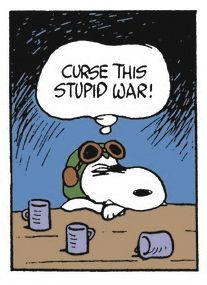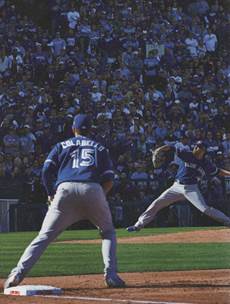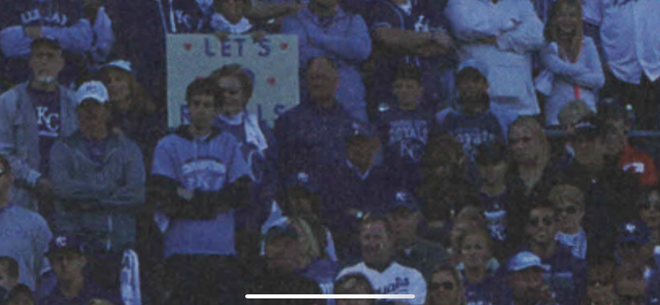The Civil War: I promise this story will end on a baseball note, so please stick with me through some battle history of the Civil War. My source is a fine book written by David Von Drehle, a Kansas City-based writer and editor-at-large for Time Magazine. I met David at a Rainy Day author event last winter and bought a copy of his Rise to Greatness – Abraham Lincoln and America’s Most Perilous Year. That year was 1862, and one of the perils was that George McClellan was in charge of the army and all but refused Lincoln’s prodding to become more aggressive in the war. McClellan was constantly saying he needed more supplies and men before he could mount a new battle. So he sat. In June, the flamboyant Confederate General J.E.B. Stuart rode all the way around McClellan’s army for reconnaissance, and on his way cut telegraph wires, collected prisoners and horses and disrupted Union supply lines. Lincoln was not pleased. In October, McClellan was again declining to move when General Stuart made yet another bold dash around the Union army, looting a major supply depot and gathering livestock. Lincoln’s response:
“Three times round and out is the rule,” he said, referring to an early version of baseball. “Stuart has been twice around McClellan. The third time, by the rules of the game, he must surrender.” Baseball as metaphor over 150 years ago.
Baseball was a budding sport prior to the Civil War. In a famous pro-Lincoln political cartoon published by Currier & Ives in September before the 1860 election, the other three candidates (Bell, Douglas and Breckenridge) were “out” and Lincoln had a “run” as he stands at home plate. His bat reads “Equal Rights and Free Territory.” The animal is a skunk, and at the time, “skunk’d” was used as a baseball term to describe a shutout or a large margin of victory. The words from each candidate/player add more baseball metaphors.

Baseball became the recreation of choice of the troops on both sides and its popularity turned it into the national pastime. The first formal rules had been introduced in 1845 by Alexander Cartwright, and #15 of his “Knickerbocker Rules” was simply “Three hands out, all out.” Hands later became at-bats and the reference was three outs per inning. Lincoln knew his baseball.
A year after the Knickerbocker Rules were published, Walt Whitman supposedly made a famous statement about baseball. My original source on this is the last line in the movie Bull Durham, delivered by Annie Savoy (as played by Susan Sarandon): “Walt Whitman once said, ‘I see great things in baseball. It’s our game, the American game. It will repair our losses and be a blessing to us.’ You could look it up.” When I looked it up, there were some vague evidence that Whitman might have said something similar to this in July of 1846. I like Annie and so accept her history.
World War II: The St. Louis Rams have escaped to LA, a relocation the St. Louis Browns attempted in 1941. Browns’ owner Donald Barnes was losing money and lacked the fan support enjoyed by the more successful Cardinals. Barnes wanted to move his team to LA and successfully gathered the support of the league president and the owners. Extensive research was done on the train travel needed to schedule the games. After the 1941 season, the owners scheduled a meeting for December 9 to vote on the move. Pearl Harbor intervened, and it was decided that there would be no relocation because war-time train travel would not be reliable.
With the war underway, there was some question if baseball should be played at all in 1942. President Roosevelt put those thoughts aside with his famous “green light” message to Commissioner Kenesaw Landis. Roosevelt, channeling Walt Whitman (see above), thought baseball was a recreational asset that was good for the morale of the nation. He noted that players eligible for the armed forces should do their duty, and if the quality of the games was lower because of the use of older players, it would not dampen the popularity of the sport.
In 1944, with many teams weakened by players joining the armed services, the still-St. Louis Browns won the AL pennant. The NL title was captured by the Cardinals. All games for this Streetcar World Series were played at their shared stadium, Sportsman’s Park, giving both teams home field advantage. In the vintage sign below, the message in the center reads “Dedicated and broadcast to all members of our armed forces throughout the world.” The Cards won in six games. It was the only pennant won by the Browns while in St. Louis (1902-1953). They moved to Baltimore in 1954.

Vietnam and War, What is it Good For?: First, a little credit to the 1970 Vietnam protest song that just made you whisper to yourself “Absolutely nothing!” You can thank Edwin Starr and Motown Records for that (click here).
There was also the Seinfeld episode when Elaine was to meet her publisher boss and a Russian writer. Jerry had kidded her that that the original title for War and Peace was War, What is it Good For? Elaine, thinking Jerry was serious, passed the bad fact along in her meeting (click here).
But enough about war. Let’s talk WAR.
WARNING. THE NEXT FOUR SECTIONS MAY ONLY BE APPRECIATED BY BASEBALL NERDS. AS MY EDITOR RITA SAID, I GOT DOWN IN THE WEEDS WITH THIS PART. SO, IF YOU ARE NOT SO INCLINED, FEEL FREE TO SKIP TO THE END FOR ROYALS FANFEST, SUPER BOWL SUNDAY AND THE GRAMMYS.
Acronym WAR: So, what is baseball WAR good for? Depends on who you ask, but its influence cannot be denied. Sportswriters refer to WAR constantly, especially during this free agency period when players, teams and agents wrestle over multi-million dollar salaries. What is behind the cryptic “Wins Above Replacement”?
When I was a kid, stats were in the paper and on the back of our baseball cards. We mostly looked at batting average (where boys first learned long division), RBI’s and homers. In pitching, it was wins, strikeouts and ERA. Other than the number of stolen bases, there were few stats related to base running. If a shortstop had good range, it was usually a subjective comment rather than a measured stat. This all changed with the explosion of advanced baseball data, and my first notice was the work of Bill James who wrote lively articles on non-standard baseball stats. He self-published his first annual Baseball Abstract in 1977, and in a bit of fortuitous timing, the baseball craze of Rotisserie (fantasy) baseball came along in 1979. I can vouch that James’ abstracts were reference points for those of us in fantasy leagues in the 80’s. James is a KU graduate and a long-time Royals fan, and he did his original baseball writing while employed as a night security guard in Lawrence. He published his last annual abstract in 1988, but he continues baseball writing and hosts a popular website. He became an advisor to the Red Sox in 2003 and has three World Series rings to show for it.
The Society for American Baseball Research (SABR) was formed in 1971 to foster research and the dissemination of the history and record of baseball. The stat work of SABR member Bill James and others of his ilk became a part of that effort. James used the SABR acronym to coin the word “sabermetrics” for the new stats. Sportswriters became intrigued and teams became aware that advanced stats were valuable in evaluating talent and determining salaries. One of the best at using the stats was the small-market Oakland team led by GM Billy Beane whose success was profiled in the Michael Lewis best-seller “Moneyball.” “Sabermetricians” also were able to up their game with the growing sophistication of computer programming and algorithms.
This led to the idea of a magic number that could summarize a player’s aggregate skills and team contribution. A baseline was needed, and the sabermetricians came up with the concept of a “replacement player”: that player who is in the top minors or just barely makes it as a bench player in the majors. The common example is the guy who is called up from the minors when a starting player gets injured. All other players on the roster are theoretically better on a relative basis and will contribute to more team wins a season, i.e. “Wins Above Replacement” or WAR. The replacement player is assigned a zero WAR and the better players have a positive WAR that is proportional to the number of wins that their composite skills will create for the team.
The computer wizards take a variety of skills of hitters, fielders, pitchers and runners, and assign a weight to each based on algorithms to add up to a final number. There are two primary publishers of WAR statistics: FanGraphs (fWAR) and Baseball Reference (rWAR). They are not interchangeable because they aggregate different skills and apply different weights, but they are generally in the same…ballpark. Theoretically, a player with a 5 WAR would improve his team by 5 more victories a season (i.e. 5 more wins than if a replacement player had been in the lineup instead). FanGraphs provides this rule-of-thumb:
Scrub: 0-1 WAR
Role Player: 1-2 WAR
Solid Starter: 2-3 WAR
Good Player: 3-4 WAR
All-Star: 4-5 WAR
Superstar: 5-6 WAR
MVP: 6+ WAR
These are the numbers for a season. When you add them up for all seasons, you get that player’s career WAR. Unless you have a lot of time and interest, I don’t recommend that you try to dig any deeper into the stat. Just accept that it is widely used by sportswriters and teams in their valuation of players. It has become an influential metric in matters ranging from naming the MVP and Cy Young winners (season WAR) to who should be in the Hall of Fame (career WAR). And, as always, money talks – WAR is often directly proportional to salary level (See Zobrist and Gordon below).
How WAR made Ben Zobrist a Rich Man: Ben Zobrist was the perfect piece of the puzzle for the Royals’ playoff run. He filled in for injured left fielder Gordon and then for second baseman Infante. He is also the poster child for WAR. In his first full season in the majors, he had a WAR of 8.6, the highest for a position player in the AL. In his 6 years with the Rays from 2009 to 2014, his cumulative WAR was second in the AL to only Miguel Cabrerra. How could this be? He has never hit .300. After hitting 27 homers in 2009, he has never again hit over 20. After his 2009 average of .297, he never again hit more than .276. Under “standard” stats, he might be a solid starter, but his WAR stats say he is an all-star or superstar. He obviously excels in the fielding, running, on-base and other traits prized by the sabermetrics community. Ben is in the odd position of being underrated by standard stats and maybe overrated by WAR. Some subjective evidence of the overrating is that he has only been in the top 10 of MVP voting one time (8th in 2009) and only played on two all-star teams. But as a free agent this winter, WAR was his friend.
The Cubs traded their second baseman Starlin Castro (projected 2016 WAR of 1.5-2.0) and signed Zobrist (2016, maybe 3 to 3.5 per the experts). Zobrist is 34, and WAR projections for players after their prime are notoriously suspect. The Cubs signed Zobrist for four years, but I’m guessing they really only expect three full-time seasons. The fourth helps spread out the big payday. WAR projections are often reduced by 0.5 per year to take into consideration aging of the player. So maybe Ben is good for 3 and 2.5 for the next two years and then maybe drops off to 1.5 at age 37. A cumulative WAR of 7.0.
Next step. The common number used this year is that a player is worth $8 million per WAR. Ignoring any inflation factor, Ben’s projected WAR of 7 over the next three years would translate to a $56 million contract. That’s exactly what the Cubs are paying him. They may get a little more with the 4th year and maybe he won’t drop off so fast in the other years. I had the benefit of hindsight in knowing the final contract number so I could make this work so well. Ben may have taken some discount because Chicago is near his hometown, and the Cubs new manager is Joe Maddon who Ben played for in his big years with the Rays.
Here are two things not found in Ben’s WAR. His versatility is not measured by WAR, and it was invaluable to the Royals and will be to the Cubs. Playoff stats are not in WAR and so do not include one lucky hit that we will always remember – Ben’s blooper in the 7th inning of ALCS Game 2 that fell between Toronto’s fielders and started the keep-the-line-moving rally that overcame a 3-0 lead. Want to see it again? Click here.
WAR and Alex Gordon/Ian Kennedy: If you project that in the next four years Alex Gordon will have WAR of 3.0, 2.5, 2.0 and 1.5, the cumulative WAR of 9 multiplied by $8 million is $72 million. Exactly what the Royals are paying him. Alex had a 2.8 WAR in 2015, but it was low because he played in only 104 games. In the prior four years, his WAR numbers were 6.6, 5.5, 3.7 and 6.6. He could legitimately be projected at 4.0 for 2016, and dropping at 0.5 thereafter, have a projected WAR of 13 – a payday of $104 million. There was a lot of buzz that he might get that much, and so the Royals waited it out. The big number did not come, but I am guessing another team would have paid something more than the Royals. The club likely benefitted from a patriotic WAR discount from Alex so he could complete his career as a Royal.
The other big free agent contract for the Royals was the 5-year deal for pitcher Ian Kennedy at $70 million. Kennedy’s WAR for his 6-year career: 1.9, 4.8, 2.5, 0.6, 3.5, 0.8. The WAR of 0.8 in 2015 is consistent with his 9-15 record and 4.28 ERA for the Padres. I can’t credibly back into a WAR scenario to get to $70 million. As discussed in my last post, Kennedy has been paid a premium with the idea of completing the puzzle that gets the Royals back into the post-season in 2016 and 2017 – before a batch of key players hit free agency. Kennedy may fare better with the good defense and strong relief pitching of the Royals. I like the take on Kennedy’s signing by Sam Mellinger in the KC Star: “like paying the surge pricing on Uber because you just really need a ride right now and you don’t want to risk waiting for a cab.”
WAR – Mistakes Were Made: Teams will continue to use WAR in their evaluations. But they all know the cautionary tale that most players peak in their late 20’s and start declining in their early 30’s. Most free agents are in this age range. The big question is always how fast will they decline. With the competitive environment to get to the post-season, the teams often project on the high side and get burned. In that case:

AND NOW TO EXTRACT YOU FROM THIS QUAGMIRE OF WAR:
Royals FanFest: Rita an I took Ian and his sister Miyo to Royals FanFest last week. Our timed tickets matched up with two of the player awards given out on stage by Dayton Moore and Ned Yost – Alcides Escobar and Wade Davis. Lorenzo Cain was not there for his player-of-the-year award. His wife was being induced to deliver their second child. Ian played some of the available games and excelled at throwing accuracy. Huge crowd – the fans are excited about 2016.
In a look-back to the 2015 playoffs, I below is a crowd shot from Sports Illustrated. Ian was reading the magazine and noticed that David Price was on the mound – so he knew it was the game he went to – #2 of the ALCS with Toronto. Since the photo had the third base crowd as the backdrop, Ian searched and found us in the stands. You won’t find us without some help. See the “LET’S” sign, scan down to the woman in front of that, then to the balding man at her left shoulder, and just in front of him, Ian (in ball cap and glove on left hand) and Grandpa (with my arms crossed and watch visible). Okay, it’s almost impossible to tell in this copied blow-up photo, but we are there. Later in that game, Ben Zobrist hit his fateful blooper.


Super Bowl Sunday: Here is a fun article on why the World Series is better than the Super Bowl (I agree). “The Super Bowl is an event. The World Series is an unedited manuscript from an inconsistently brilliant author.” Don’t miss the photo and copy of our Hot Stove reader David Block in the “Location” section. I especially like the last paragraph that concludes that the World Series is better because it contains more baseball than the Super Bowl. And great stats like WAR. Click here.
The Grammys: Rita and I usually tune in to the Grammys as sort of a courtesy call to music we rarely listen to. That is not a complaint – I am all for each generation creating its own music and memories, just as we did with rock ‘n’ roll in the 50’s and 60’s. I think we bought two CD’s this past year and luckily both are nominated for a Grammy. Of course, you have to scroll fairly far down through the 83 categories to find them. Up for best folk album is Tomorrow is my Turn by Rhiannon Giddens. We became fans of Giddens when we watched a Showtime special about the recording of the Dylan-inspired New Basement Tapes. Bill Shapiro brought her to town in October for his “Cypress Avenue Live” at the Folly Theatre. Her barefoot performance brought the house down.
With apologies to our friends who may be tired of us promoting this show and album – the Broadway cast album for Hamilton is nominated in the musical theater category. The cool thing is that the cast will perform at the Grammys via satellite from the NY stage. The 35-year old Lin-Manuel Miranda who wrote, directs and stars in the Broadway show is a genius. The casting of a multi-racial cast as the founding fathers is inspired. The plan to remove Hamilton from the $10 bill may be endangered by this show (that’s Miranda in this image):

Tune in on Monday, February 15, but consider this hint: We DVR and start maybe an hour later so we can skip the ads and weak parts of the show. Second hint: Check out in advance the lyrics on Hamilton – they sing at 144 words per minute and it helps to have heard it before. We believe they plan to perform the opening number from the show. And to end with the beginning – please remember Lincoln’s Birthday on February 12. He was in a league of his own.
One thought on “Hot Stove #5 – War and WAR, What are They Good For? – From A to Z, Abe Lincoln to Ben Zobrist”
Comments are closed.